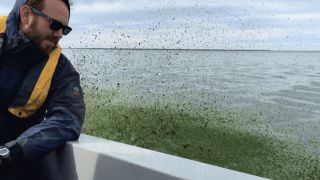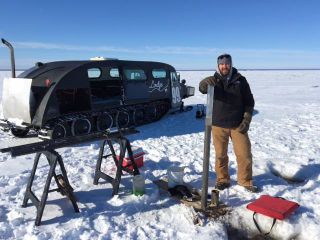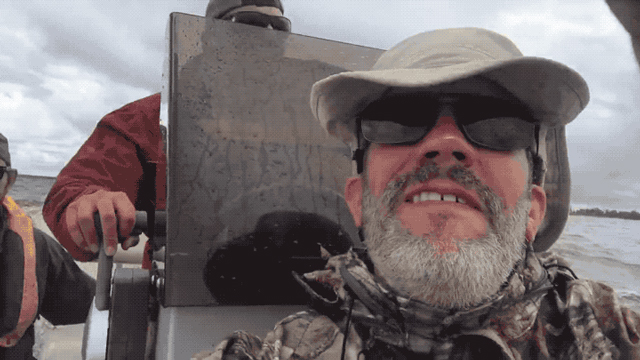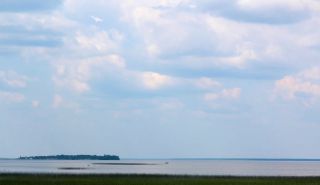This article was originally written by Greg Seitz in 2018 for Field Notes -Stories from the St. Croix Watershed Research Station of the Science Museum of Minnesota; it is used here with permission of the SCWRS.
 Dr. Adam Heathcote boating through a bloom of blue-green algae on Big Traverse Bay. (Courtesy Dr. Mark Edlund)Spanning the U.S.-Canada border at the northern extremity of Minnesota and the northwestern corner of Ontario, vast Lake of the Woods has a storied relationship with humans: as home, as highway, as getaway. Its waters are full of fish, and its 6,500 miles of shoreline (including 14,000 islands) scattered with docks, beaches, and outposts.
Dr. Adam Heathcote boating through a bloom of blue-green algae on Big Traverse Bay. (Courtesy Dr. Mark Edlund)Spanning the U.S.-Canada border at the northern extremity of Minnesota and the northwestern corner of Ontario, vast Lake of the Woods has a storied relationship with humans: as home, as highway, as getaway. Its waters are full of fish, and its 6,500 miles of shoreline (including 14,000 islands) scattered with docks, beaches, and outposts.
There are big walleye, northern pike, and sturgeon, endangered piping plovers and terns nesting on islands, and visitors that come from afar and spend tens of millions of dollars in the area each year.
Lake of the Woods is well-loved, and troubled.
For much of the twentieth century, paper and lumber mills on the lake’s largest tributary, the Rainy River, dumped hundreds of tons of sawdust and other waste into the water. Cities and septic systems also emptied into the river. The lake was filled with nutrients that still feed blooms of nuisance algae today.
The pollution mostly stopped in the 1970s, after Congress passed the Clean Water Act — but problems persist. Algae are poisoning pets, fouling the water, and hurting the region’s lake-based culture and economy.
Now, scientists have started to explain why Lake of the Woods can’t get past its past: the nutrients dumped in decades ago have been slow to get buried or flow out.
Several years of intensive study by the St. Croix Watershed Research Station and its partners, with funding from the Minnesota Pollution Control Agency, have included deploying monitoring buoys to take constant measurements, extracting cores of mud from its bottom, and creating computer simulations to understand connections between land and water and weather.
It has also included bone-jarring boat rides and remote research, as well as head-scratching problems. The questions they seek to answer have big implications for the lake’s future — getting it back to its pre-polluted state could be complicated.
The Green Great Lake
Lake of the Woods is about 70 miles long by 50 miles wide. At 1,600 square miles, it’s larger than the state of Delaware. Its shoreline is longer than Lake Superior (it’s sometimes called the “Sixth Great Lake”). In a sense, it is two lakes — the shallow southern basin where the Rainy River enters, and the northern half, which is rocky, island-studded, and deeper.
These facts and other elements of the lake’s unique history, geography, and function are inter-connected, and that makes it hard to restore the water quality.
Together, the various forces at work mean the lake is sensitive to changes, with even slight increases in phosphorus in the water having a significant impact on how much algae grow. And the phosphorus that is still flowing into the lake is not easy to reduce.
Lastly, algae blooms are not new to Lake of the Woods. Fur traders and early European visitors even made note of it.
In July 1823, Lake of the Woods was described as “foul, frequently covered with a green scum of vegetable matter.” In 1850, “always greenish.” In August 1857, the southern basin was described as “tinged with green deriving its colour from a minute vegetable growth, until it gave the appearance to the lake of a vast expanse of dirty green mud.”
But yet, the algae are still a problem today. The reasons are “counterintuitive,” according to recent papers by Research Station staff and other scientists published in a special issue of the peer-reviewed journal Lake and Reservoir Management.
A Growing Problem
 Heathcote poses with a sediment core extracted through the ice. These tubes of mud provide important insights into the historic water quality.(Photo courtesy Mark Edlund)The lake’s prolific algae can have a big impact on the water and the people who use it. Cyanobacteria, also called blue-green algae, thrive in nutrient-rich waters and produce toxins that can poison pets and people. Dogs have died in recent years after being exposed to the toxins while swimming in the lake.
Heathcote poses with a sediment core extracted through the ice. These tubes of mud provide important insights into the historic water quality.(Photo courtesy Mark Edlund)The lake’s prolific algae can have a big impact on the water and the people who use it. Cyanobacteria, also called blue-green algae, thrive in nutrient-rich waters and produce toxins that can poison pets and people. Dogs have died in recent years after being exposed to the toxins while swimming in the lake.
Because of high nutrient levels and harmful algae resulting from the lake’s increased fertility, Minnesota declared the parts of Lake of the Woods within the state’s borders “impaired” in 2008. The designation kicked off intensive research, which informed a clean-up plan to be released by the Minnesota Pollution Control Agency this year.
Lake of the Woods spans an international border, but collaborative management efforts, which could be difficult, have been a major part of its past, and will be part of its future. Cross-border partnerships are fostered and coordinated by the Lake of the Woods Water Sustainability Foundation, with partners focused on protection and sustainability of the lake.
Understanding the lake’s past and current condition and figuring out what forces affect the water quality are essential to setting clean-up goals and identifying the most effective ways to achieve them.
Changes in how phosphorus moves through Lake of the Woods
 Lots more nutrients are being buried in the bottom sediments than before humans started to significantly affect the water quality. Some of it can be stirred up and returned to the water when wind and other conditions are right.
Lots more nutrients are being buried in the bottom sediments than before humans started to significantly affect the water quality. Some of it can be stirred up and returned to the water when wind and other conditions are right.
What the researchers found was that the lake has a long history of algae blooms, and that six decades of dumping harmful substances into the water is still affecting the lake as nutrients are released from the bottom sediments.
However, more than 40 years after stringent rules to reduce nutrient loading were put in place, the lake is possibly headed toward a new “steady state” — but that stable condition might not ever look quite like it did before being polluted.
That’s because while the amount of phosphorus flowing into Lake of the Woods has been drastically reduced, the algae have not followed suit and can reach levels similar to what they were in the pollution hey-day of the 1960s.
Why Is It Worse?
Cyanobacteria are always present in lakes. One of the oldest groups of organisms on Earth, they can survive a broad array of conditions. But when it is warm, sunny, and there are lots of nutrients in the water, their population can explode in what’s called a “bloom.”
That’s when blue-green algae become a poisonous problem. Their toxins can harm skin, kidney, lung, and brain functions.
Reducing the nutrients should reduce the algae, according to the same logic. But, forty years after turning off the faucet of pollution on the Rainy River, there’s been plenty of phosphorus to fuel algae blooms in in Lake of the Woods.
There are a few reasons for that, and they are complex and connected to each other.
First, a lot of the nutrients from the decades of dumping have stayed in sediments on the bottom of the lake. This means they don’t stay suspended in the water and flow out of the lake at Kenora, Ontario, headed for Lake Winnipeg.
In many lakes, those nutrients would be quickly buried in the mud, unavailable for growing algae. But not in Lake of the Woods, especially the vast southern basin. That’s because of issue number two.
The second factor is that a big expanse of water is subject to lots of winds and waves. Ask anyone who has fished the lake, or the scientists who study it. They have to plan trips with a close eye on the weather forecast, and have still been caught in rough conditions, with bruised tailbones and seasickness to show for it.
Sea sick yet?
 Mark Edlund captured this video of a rough return trip in a boat piloted by Jordan Donatell of the Minnesota Pollution Control Agency. (note: video animation removed for bandwidth reduction)
Mark Edlund captured this video of a rough return trip in a boat piloted by Jordan Donatell of the Minnesota Pollution Control Agency. (note: video animation removed for bandwidth reduction)
In other words, the lake is still paying for the sins of its past
Where To From Here
 Southern Lake of the Woods, seen from Baudette, Minnesota. (Photo by Greg Seitz)The upside of the phosphorus being returned to the water from the sediments is that the nutrients can ultimately flow north and out of the lake through the Winnipeg River. It takes one to two years for water to move through Lake of the Woods, a relatively fast pace.
Southern Lake of the Woods, seen from Baudette, Minnesota. (Photo by Greg Seitz)The upside of the phosphorus being returned to the water from the sediments is that the nutrients can ultimately flow north and out of the lake through the Winnipeg River. It takes one to two years for water to move through Lake of the Woods, a relatively fast pace.
That is also why it appears the lake is headed for a new normal. The historic phosphorus is dwindling, and soon enough, there won’t be as much available in the sediments to get stirred up.
But other forces are at work.
Climate is one of them. Thanks to shorter winters and frozen conditions, the growing season for algae is almost a month longer than fifty years ago in some parts of the lake.
Less obvious is that climate change-connected shifts in wind and precipitation patterns could affect how nutrients move from the sediments to the water.
Changes to how the lake’s water mixes together and moves nutrients upward, increases in the amount of nutrients that settle in the sediments but find their way back to the water, and a stronger divide in the lake between warmer, oxygen-rich upper waters and colder, low-oxygen waters on the bottom all play a part in Lake of the Woods’ unique and complicated behavior.
And it may not just be a phosphorus problem.
Monitoring by the Research Station has uncovered another twist in the story: In most lakes in the Upper Midwest, the amount of algae that grows is limited by how much phosphorus is available. But in Lake of the Woods, nitrogen may be the key factor during the summer and fall seasons.
Cyanobacteria can take advantage of this. Some of these harmful organisms can overcome nitrogen limitation by getting it from atmospheric sources, getting the upper hand on other types of algae.
This means that focusing only on managing phosphorus may not fully address the lake’s algae woes.
And finally, there is the fact that the southern bays of Lake of the Woods have probably always been prone to algae blooms. By better understanding this history, the many people who want to keep the lake clean and healthy can set realistic goals and get to work meeting them.
References:
